If you’re moving into a new home and notice a strong dog smell lingering on your wood floors, don’t panic. Even with potty training and a lot of effort, accidents can happen, leaving behind urine stains and unpleasant odors. The good news is that restoring your hardwood floors and making them fresh again is possible.
Start by choosing safe cleaners that effectively tackle dog urine and will not harm your flooring. A well-compiled guide with expert recommendations can help you find the best practices to eliminate the issue efficiently.
Different cleaning solutions are available, from DIY remedies to commercial products. Some of the most effective options include enzymatic cleaners, which break down odor-causing bacteria, and natural solutions like vinegar and baking soda. If you plan to paint the walls, this could also help reduce lingering smells.
It’s essential to read instructions carefully and follow best cleaning practices to achieve the desired results. With a good plan and the proper cleaning methods, you can confidently maintain the timeless charm of your beautiful hardwood floors, making your space welcoming and odor-free. Hopefully, these tips will help you enjoy a fresh-smelling home, free from the worry of pet mishaps and accidents.
Understanding the Challenge
Dealing with pet urine on wood floors can be challenging because it contains a potent combination of water, ammonia, urea, bacteria, and waste products. When urine seeps into the porous surface of the wood, it creates an unpleasant odor that can be challenging to remove.
Many traditional cleaning methods may not suffice, as they only temporarily relieve the smell by masking it rather than fully addressing the underlying issue. The key to adequate odor is specialized techniques that break down the urine compounds and reach deep into the wood grain. Ignoring the problem can lead to long-term damage and lingering smells, making it essential to act quickly and choose the right cleaning solutions.
Getting Dog Urine Out of Wood Floors: What You Need
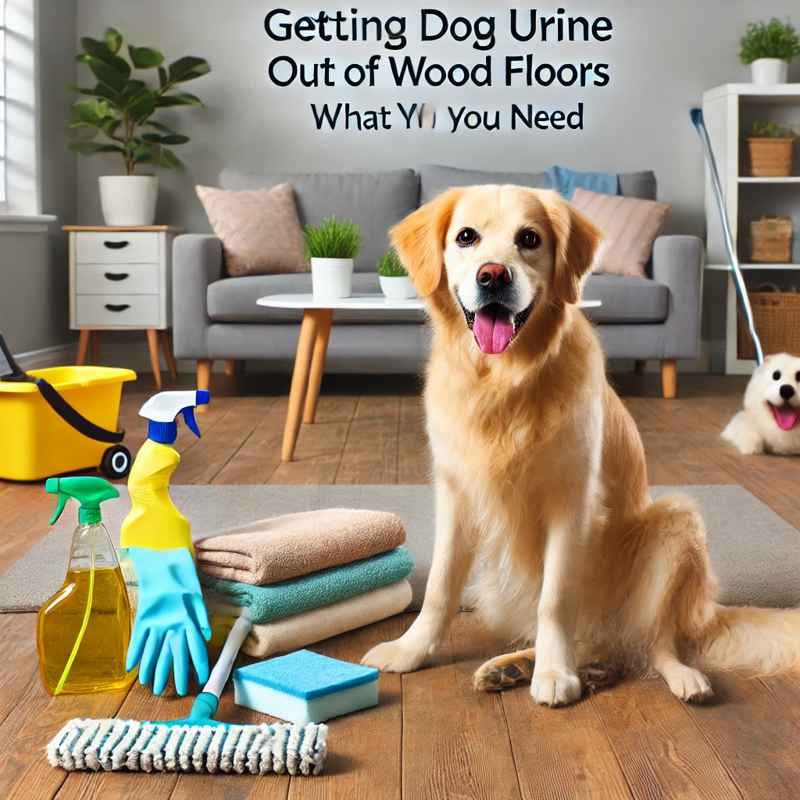
Dealing with a stinky mess on your beloved wood floors can be frustrating, but you can effectively tackle the issue with the right approach. As an experienced pet owner, I know that having the right cleaning products is crucial.
Whether a newbie or an expert, you don’t need to waste time and money buying expensive stain removers or odor-eliminating sprays at the store. Instead, you can use simple household items like white vinegar, baking soda, dish soap, and hydrogen peroxide (3%) to break down and remove stains.
Before you start, ensure you have protective gloves, paper towels, old rags, and a vacuum cleaner. An optional pet stain remover can be helpful if the stain is stubborn. These basic supplies will help you clean up the mess and keep your home fresh without unnecessary effort.
Step-by-Step Guide to Remove Dog Pee from Wood Floors
When dog pee is on your wood floor, don’t worry—we have you covered with this step-by-step manual that will tell you precisely how to clean it properly. Whether the accident is recent or old, following the proper method can help you eliminate the odor and restore your floors to their original condition. Being well-prepared with the right cleaning materials and techniques is key to keeping your home fresh.
Step 1 – Soak Up the Dog Pee
First, soak up the pee immediately to prevent further damage. Whether your floors are sealed or unsealed, they can absorb the urine, causing a strong smell that’s tough to eliminate. Start by opening the windows to let in fresh air, then use protective gloves and paper towels to begin cleaning. Avoid rubbing, and gently dab to remove the liquid and prevent scratches on your beautiful wood floors.
Step 2 – Clean the Spot with Hydrogen Peroxide
Once the area is dry, it’s time to clean the spot thoroughly using a mix of hydrogen peroxide and dish soap. Inspect the area for any stains, as older stains may have been absorbed deep into the wood. Mix a small amount of hydrogen peroxide with dish soap in a bowl, then apply it to the stain with a clean rag. Let it sit for about 15 minutes, then wipe it away with a dry towel to prevent discoloration or damage to the floor. Always do a spot check in an inconspicuous area before applying to the entire stain.
Step 3 – Use Baking Soda to Remove Odors
To tackle any lingering odors, use baking soda, a powerful odor-neutralizing agent. Sprinkle a generous amount over the affected area and let it sit overnight to absorb the stench and neutralize the acidity of the urine. In the morning, sweep or vacuum up the residue to leave the floor fresh and clean. If needed, a second round of baking soda or a mixture of vinegar and water can help eliminate any persistent smells. This method is effective, affordable, and commonly available in every home.
Step 4 – Kill Germs with White Vinegar
Apply a mixture of white vinegar and water to clean and ensure germs are removed thoroughly. Rub the solution onto the floor using a rag, then wash it with a dry towel. Make sure to allow proper airflow by using a hair dryer to speed up drying and avoid moisture buildup, which could cause discoloration or damage to the wood. This method is excellent for disinfecting the area and keeping it bacteria-free.
Optional Step – Use a Pet Stain Remover
If the DIY methods don’t provide the desired results, an optional pet stain remover can be a good alternative. Choose a product carefully by reading the ingredient list and avoiding harsh chemicals that might damage the floor.
Follow the instructions properly to remove the stains and odorant leaving residue safely. Some cleaners are too mild to do the job effectively, so it’s always good to try different household ingredients before investing in commercial products.
Optional Step – Protect Your Floors
Protecting your floors by applying a sealant to prevent future accidents is wise. If you’re a pet owner, investing in sealing your wood floors can be worth it in the long run. Consider re-sealing the floors if your furry friends have had multiple accidents.
Many pet-friendly flooring options make cleaning and maintenance much more manageable. Proper planning and care will keep your house fresh and prevent future messes from becoming a hassle.
Best Ways to Clean and Remove Dog Pee Smell from Hardwood Floors
This guide has helped many pet owners learn how to properly clean dog pee from a wooden floor without too much effort or expensive investment. The process should be followed each time your dog has an accident in the house to prevent the lingering smell from coming back.
Even tiny drops of urine left behind can make it likely that your dog will return to the same spot and pee again. If you prefer cleaning yourself, use proper methods, but if the issue persists, it’s best to contact Certified Clean Care for professional services.
Their expert professionals will leave your floors spotless, so don’t hesitate to book a consultation or call them today.
Cleaning Up Pet Urine from Different Types of Floors
Regular cleaning of pet urine is essential to maintain the quality of your floors. Different types of flooring, such as Marmoleum, vinyl, laminate, limestone composite, carpet, and hardwood, require specific care.
Some floors are more water-resistant and even waterproof, making them easier to clean, while others need extra attention. Knowing the essential points of cleaning each flooring type will help prevent damage and lingering odors.
Solid Sheets vs. Planks or Tiles
When dealing with solid flooring sheets, you have an advantage because they resist moisture better due to the absence of gaps. However, planks and tiles can let liquids seep underneath if the pieces are not fitted tightly. This makes cleaning more challenging as moisture can remain trapped, causing persistent odors and potential damage over time.
Replaceable Planks or Tiles
Some brands, like Torlys, offer specialized tools for flooring with replaceable planks or tiles. One such tool is the Bulldog, which allows you to remove and replace a single plank or tile. This is particularly helpful when liquid has leaked underneath, making it easier to address deep-seated odors without replacing the entire floor.
Manual Cleaning
If the urine has seeped into the floor, lifting the flooring and using a diluted bleach solution is crucial to prevent mold from growing. Always follow safety tips, such as ensuring proper ventilation and keeping pets away during cleaning. Thorough checking under the flooring can help identify hidden urine spots that might cause persistent odors.
Odorant Safety Tips
Using bleach to clean urine requires caution. Never mix it with vinegar, as it creates toxic gas. Ensure the urine is soaked before applying bleach, as it might react with the ammonia in pet urine. Always ensure good ventilation and keep pets away from the area during the cleaning process to avoid harmful exposure.
Professional Help
If cleaning efforts are unsuccessful and the urine penetrates the flooring, you may need professional help. If you’re unable to lift the flooring, it is advisable to call experts with the right tools and experience to handle the problem effectively.
DIY Cleaning Solutions
If there are no visible signs of leakage, a simple DIY cleaning solution can help. Use a vinegar rinse or an enzyme cleaner to remove odors from Dorset and hardwood floors. These solutions are often easier to apply and work effectively to eliminate lingering smells.
Cleaning Tiles
When cleaning ceramic or porcelain tiles, it’s important to note that they are designed to resist water and are relatively easier to clean. However, the grout between tiles can be porous, allowing odors to odors. Applying vinegar or an enzyme cleaner and letting it sit can help remove lingering odors. Generally, tiles are less likely to stain or hold smells than other flooring types.
DIY Solutions to Remove Dog or Cat Urine Smell from Carpets or Floors
Hydrogen Peroxide Rinse
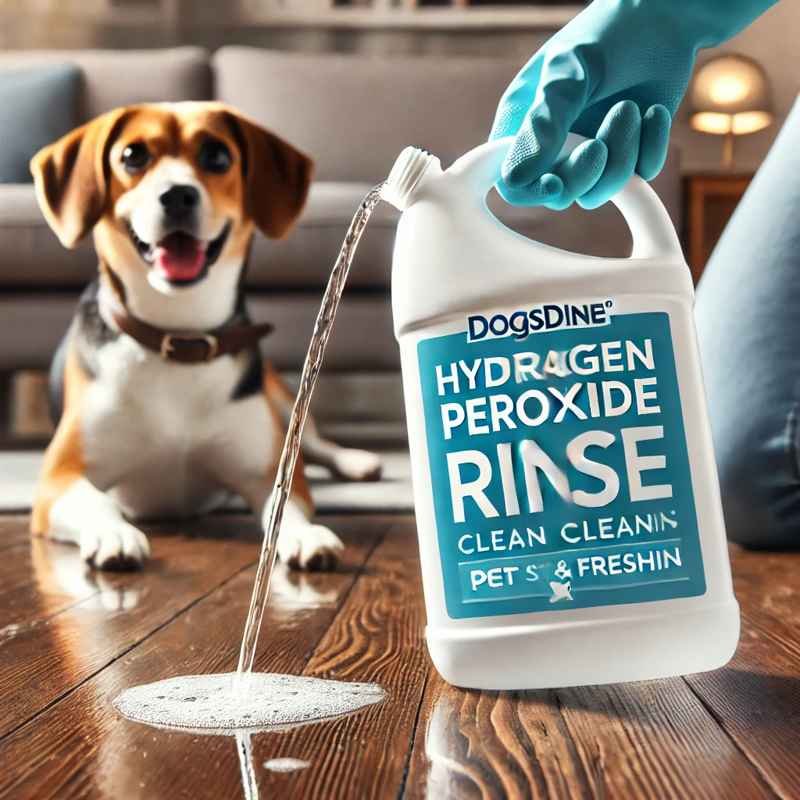
You can use a hydrogen peroxide rinse to remove dog urine from your floors. Mix equal parts of hydrogen peroxide and water, then dampen the affected area with the solution. Let it rest for at least 15 minutes, allowing it to break down the odor afterward; blot the spot using paper towels to absorb any leftover liquid. This method works best for minor accidents and helps to refresh the floor quickly.
Baking Soda and Vinegar Solution
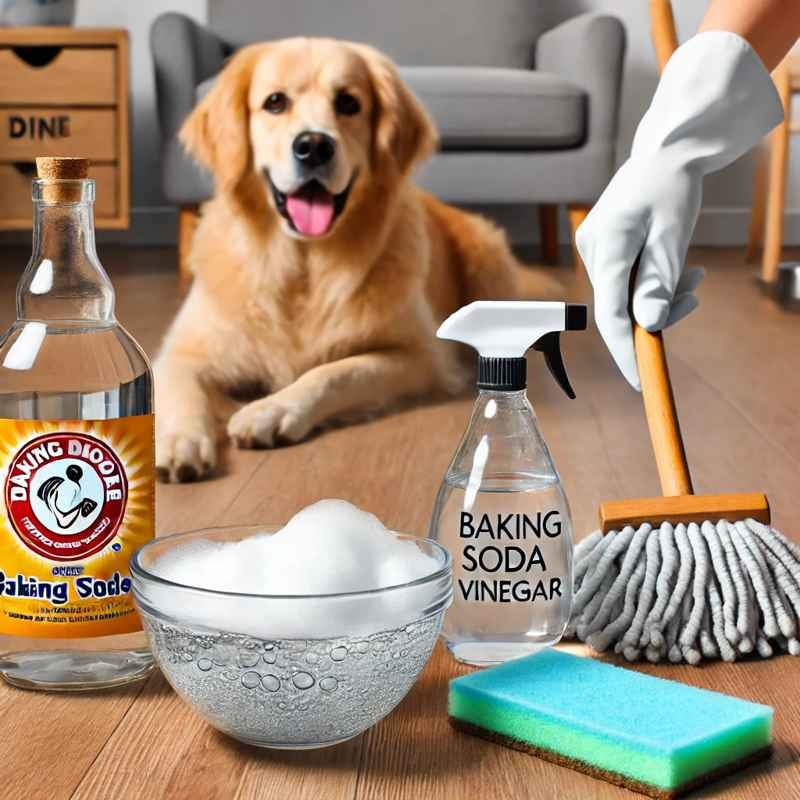
After wiping the area, sprinkle a generous amount of baking soda over the spot. Then, pour a small amount of vinegar over the baking soda, letting it fizz and bubble. This combination helps neutralize the urine smell and break down stains. Allow the mixture to rest overnight, then vacuum the spot the next day to remove the dried residue. This method is excellent for treating carpet, hardwood, or tile flooring.
Steam Cleaning
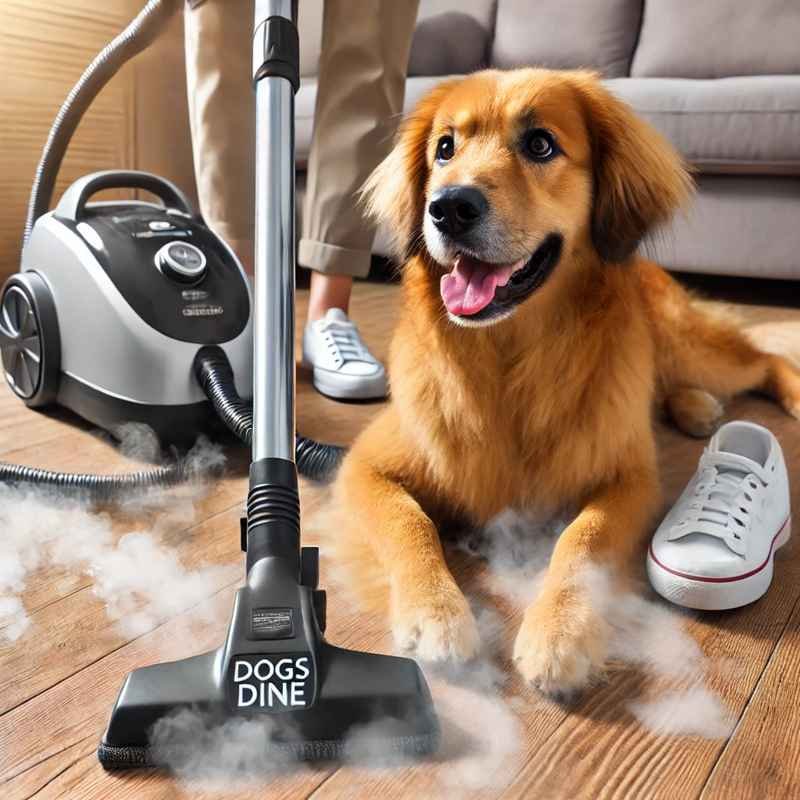
Using a steam cleaner can be an effective way to remove pet urine from floors. Fill the cleaner with clean water and move it slowly over the affected area. The heat from the steam penetrates deep into the surface, helping to break down the urine and remove bacteria. Ensure the area is thoroughly dried afterward to prevent moisture damage. Steam cleaning is beneficial for hardwood and laminate floors.
Essential Oil Deodorizer
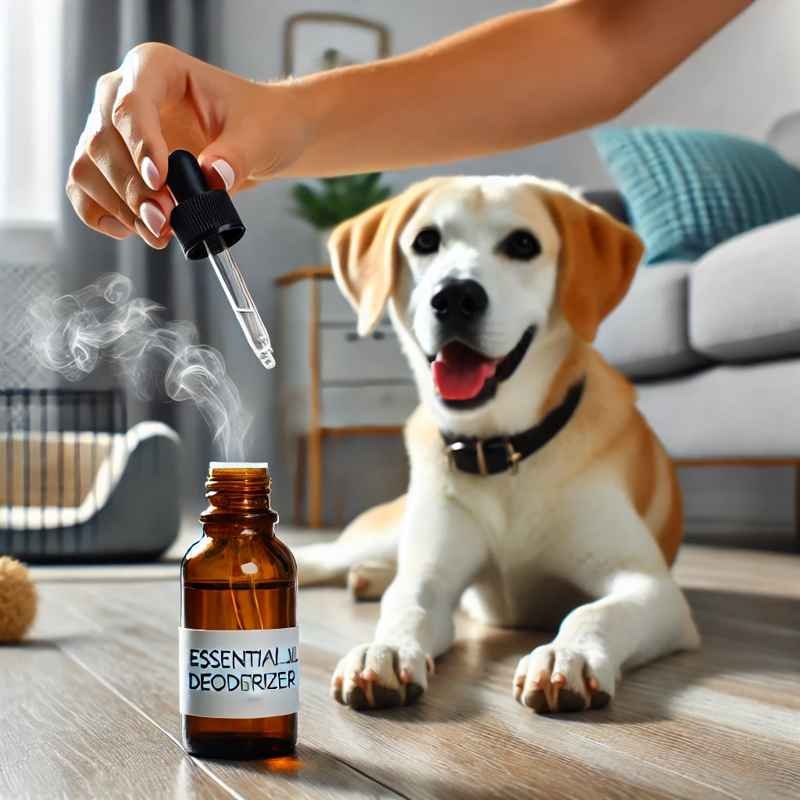
For a fresh-smelling home, try using an essential oil deodorizer. Mix equal parts of water and a few drops of your favorite essential oil, such as lavender or tea tree, in a spray bottle. Lightly dampen the area with this solution, allowing it to sit for a few minutes before wiping it off with a clean cloth. This method eliminates pet odors and leaves your home smelling pleasant.
Important: Always Test Before Applying
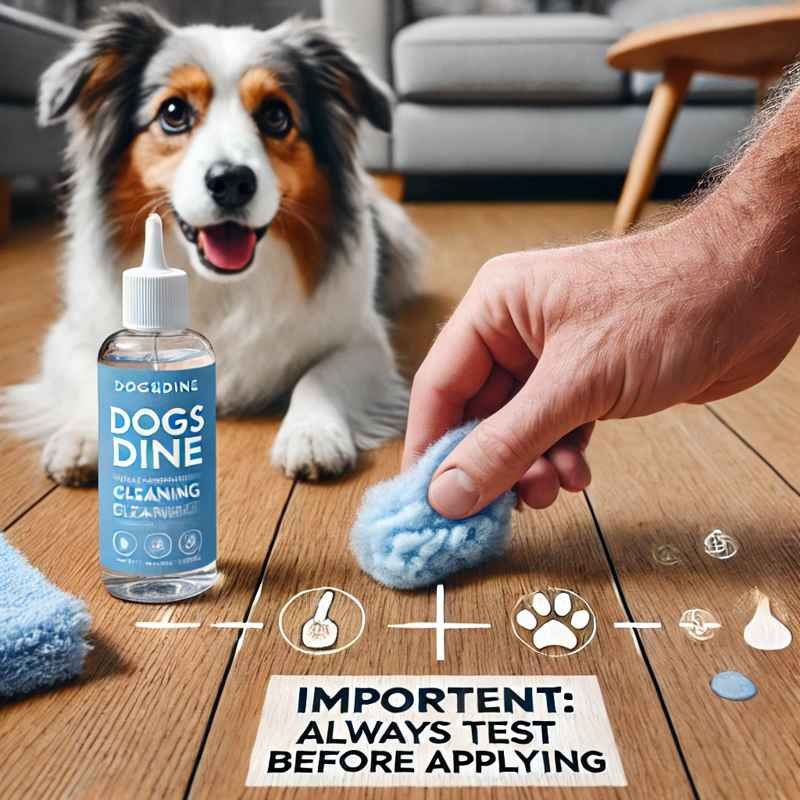
It’s important to always test any solution on a small area before applying it to the entire floor. Some solutions, such as hydrogen peroxide and vinegar, can be too harsh for specific finishes and may cause discoloration. Never mix hydrogen peroxide with bleach or other strong chemicals, as it can produce harmful fumes.
Professional Enzyme-Based Cleaners

If DIY solutions don’t work, consider using enzyme-based cleaners such as Nature’s Miracle. These cleaners work by breaking down proteins found in pet urine and are a great option when dealing with stubborn smells. Follow the product instructions carefully to get the best results and keep your floors odor-free
When to Call in the Professionals
Sometimes, no matter how much effort you put into cleaning, completely removing dog urine smell and stains on your own can be difficult. If you’ve tried multiple cleaning methods without success, it may be time to seek professional help. It’s best to call experts with the right tools and knowledge to handle stubborn odors and deep stains in specific situations.
If you discover the accident a long time after it happened and none of the methods you’ve tried seem to work, the urine may have already soaked deep into the wood. Old stains are more challenging to remove, and lingering smells can make your home uncomfortable. In such cases, professionals use advanced techniques to extract deeply embedded odors and restore the wood’s freshness.
Another reason to seek expert assistance is if the dog urine or a cleaning product has damaged the finish of your hardwood floors. Using the wrong cleaning products or scrubbing too hard can strip the protective layer, making the wood more prone to absorbing urine in the future. Professionals can assess the level of damage and recommend the best way to repair or refinish the floors without causing further harm.
If you believe the urine has soaked under your flooring and you can’t lift it to clean beneath, it’s crucial to get professional help. This is especially important if the area feels softer than the rest of the floor, as it may indicate damage to the wooden subfloor.
Ignoring this issue could lead to costly repairs, so it’s best to address it sooner rather than later. If you’re dealing with pet-related accidents, you might also wonder, Can Dogs Eat Broccoli Rabe? While it’s a nutritious green, it contains compounds that can significantly harm dogs.
Knowing when to call professionals can save you time and effort while ensuring your floors remain in top condition. Whether the odor is consistent, the floor finish is affected, or the urine has seeped below the surface, getting expert assistance is often the most effective solution.
Can Robot Vacuums Remove Dog Urine Smell from Floors?
Keeping your floors fresh and free from dog urine odor requires regular upkeep and proper cleaning. While robot vacuums can help eliminate surface-level dirt, they may not be enough to handle deep-seated smells. The best approach combines specific treatments and deep-cleaning techniques to ensure the ododoroesn’t linger in your carpets or floors.
Regular Vacuuming
Regular vacuuming is crucial to combat deodorized pet hair, dander, and dirt trapped deep in your floors and carpets. Vacuuming at least twice a week can significantly reduce the smell, especially in areas where your pet spends time. While vacuuming can’t remove the odor entirely, it helps keep the surface clean and prevents further buildup that could worsen the smell.
Using the Right Robot Vacuum
Choosing the correct robot vacuum can make a big difference in maintaining a clean home. For added convenience, consider advanced models such as the Eufy S1 Pro, which can refresh the mop while cleaning. This feature sets it apart from other models that lack this ability. The eufy S1 Pro provides an excellent choice for a cleaner, fresher home by offering deep-cleaning capabilities while reducing daily maintenance efforts.
Floor-Washing Robot Vacuums
Some advanced models, like the world’s first floor-washing robot vacuum, offer real-time self-cleaning combined with powerful vacuuming. With their innovative design, these devices help remove urine residue and say goodbye to manual cleaning. They provide an automated solution that ensures a thorough cleaning and keeps your floors spotless and odor-free.
Steam Cleaning for Deep Odor Removal
While robot vacuums can help with surface cleaning, steam cleaning removes dog urine smell from floors. Hot steam eliminates bacteria and breaks odors without being used. You can rent a cleaner from a hardware store and use it to deep clean the area without soaking the floor too much, as excessive water can cause mold to grow and lead to further problems.
Additional Strategies to Keep Your Home Odor-Free
Grooming Tips to Keep Your Home Odor-Free
Regular grooming is an effective way to keep your dog and home smelling fresh by reducing odors. Eeu, brush your pet regularly to remove loose fur and cut down dander, which can contribute to unpleasant smells. Bathe your dog using pet-safe shampoos to keep their coat clean and free of dirt and bacteria. Additionally, taking care of their teeth helps to prevent bad breath and saliva smells that can linger on floors and furniture. Keeping up with these habits will minimize shedding and dander buildup on your carpet and other surfaces.
Effective Ways to Remove Dog Urine Smell from Floors
Cleaning the area immediately is essential to tackle dog urine smells on your floors. A pet-safe enzyme cleaner is the best way to break down the urine and remove the od. If the smell persists, you may need to repeat the cleaning process until thodorrs rare s is one. Acting quickly prevents the urine from soaking deep into the wood, making it easier to maintain a fresh-smelling home.
Quick Fixes for Urine Stains on Hardwood Floors
If your hardwood floors have urine stains, blot the area with a clean cloth to absorb as much liquid as possible. Then, gently remove the stain by applying a hardwood floor cleaner or a mixture of vinegar and water. Avoid saturating the wood, as too much moisture may lead to damage. Instead, wipe gently and allow the area to dry thoroughly to prevent any long-term damage to your floors.
Consult the Wood Floor Experts at Flooring Direct
If your wood floors are plagued by stubborn pee odors and regular cleaning methods have failed, it may be time to seek professional help. In some cases, replacing sections of your hardwood flooring might even be necessary. In Tucson, AZ, Flooring Direct offers expert flooring services across areas such as Marana, Oro Valley, Casas Adobes, and Catalina Foothills.
Their team of skilled professionals is equipped to tackle even the toughest pet-related challenges, ensuring your floors look beautiful and smell fresh. Whether you need a deep clean or a complete flooring replacement, their specialists can provide the right solution to keep your home odor-free.
FAQS
To eliminate the nasty smell of dog urine from your wood floor, combine vinegar and baking soda on the urinated area. This natural solution helps break down the odor without harming the wood. If the urine has saturated deeply into the wood, the problem may be more challenging to deal with, requiring multiple applications of cleaning products. Using hydrogen peroxide can also help, but it should be used carefully to avoid discoloration. For persistent odors, you can try ozone treatment using an ozone machine, which effectively neutralizes deep-set smells.
Yes, you can quickly clean pet accidents by using a mixture of white vinegar and water. This natural solution effectively neutralizes odors without damaging wood.
The best solution for cleaning animal urine from hardwood floors is to moisten a soft, absorbent cloth, such as a rag or felt, and apply it to the spot. Allow it to sit for a few hours to work effectively. This method removes stains and odors, ensuring your floors stay clean and fresh.
Yes, hydrogen peroxide can potentially damage wood floors if misused in high concentrations. It may bleach the surface, resulting in discoloration.
Conclusion
Use effective cleaning methods and regular pet care to keep your wood floors free of odors. Solutions like enzyme cleaners, vinegar, and baking soda can help remove stubborn smells, while professional help may be needed for deep-set stains. With the right approach, you can even enjoy an odor-free home.

